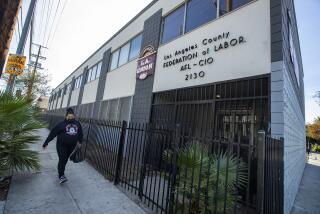Advisor Defends His Proposal for Valley Secession
- Share via
The lead author of a new plan for San Fernando Valley secession responded Wednesday to a storm of opposition by saying the proposal would offer the new city “tremendous leverage and control over its own destiny.”
The plan would avert disruption of city services and protect thousands of municipal employees from layoffs if the Valley were to break away from Los Angeles, said Keith D. Curry, who led the team that drafted the proposal.
The Valley independence plan released Friday sparked an uproar among secessionists, because it would require the new city to contract with Los Angeles for police and fire protection, trash collection and all other municipal services. They called it “a recipe for disaster,” “the lazy way out” and worse.
It calls for a mayor and city council to govern the new Valley city with just 19 employees. The city would pay Los Angeles $1 billion a year--just short of its entire treasury. After a year, it could hire other contractors or provide its own services, but any separation from Los Angeles would be subject to negotiation with City Hall downtown.
“Some might say the Valley is not a true separate entity,” Curry told the Local Agency Formation Commission, which is considering whether to put secession before voters. “But this is precisely the same model used universally in California for new cities. Lakewood has contracted with the Los Angeles Sheriff’s Department for nearly 50 years. Does anyone believe they’re not a real city?
“The new city would control a billion-dollar checkbook for the purpose of service, thus giving it tremendous leverage and control over its own destiny,” he added. “The new city would control land-use decisions within its boundaries, a key issue of local control.”
Most important, he said, the Valley city “would have its own elected leadership.”
Curry is a managing director of Public Financial Management, a Philadelphia consulting firm hired by LAFCO to study secession and craft a plan that could be put on the November 2002 ballot.
After public hearings that begin tonight, LAFCO could revise the plan. Separatists are pushing for a Valley city with more control over its finances and operations, along with a fair share of the city’s assets.
“It’s a sad excuse for a report, in our opinion, but we’re going to work with it,” said William Powers, a board member of the Valley VOTE secession group.
City officials have voiced their own concerns. Councilman Dennis Zine called the plan “ridiculous,” “bizarre” and “absurd,” saying it was too vague to put on the ballot.
To calm the debate, Curry laid out the legal constraints on the creation of a Valley city: It must be fiscally viable, it must not harm the rest of Los Angeles, and city employees must not be laid off before the expiration of their union contracts. Otherwise, he said, the ballot proposal would be vulnerable to court challenge.
The consulting firm was forced to abandon its earlier plan for a wholesale split of the city work force and all of its agencies after Los Angeles City Hall raised thousands of objections, he said. He questioned the city’s motives, suggesting City Hall was trying to undermine secession by making it seem too expensive and disruptive to city services.
At the same time, the consultants did not want to “second-guess the city’s own managers,” Curry said.
Among the consulting firm’s top concerns: the possibility that thousands of Los Angeles employees would refuse to take new jobs with the Valley city, leaving LAFCO to transfer them against their will.
“How would we choose among the employees?” Curry asked.
Under the new plan, any decisions on employee transfers would be left to the elected officials of Los Angeles and the Valley city.
Curry also responded to secessionists’ anger over the absence of parks and other assets for the Valley city in the new plan. He told the commission, “We welcome your policy direction on how to address the issue of fixed assets and any related compensation issues” in the final ballot proposal.
For now, City Hall and Valley VOTE plan to negotiate over the next several weeks on key aspects of the ballot measure, including proposed “alimony” payments from the Valley city to Los Angeles. LAFCO Executive Officer Larry J. Calemine said a moderator might be needed to avoid “a screaming match.”
Mayor James K. Hahn and the City Council have called for the negotiations to take place in public. But LAFCO commissioners plan to start the talks with a private meeting with Hahn on Oct. 19 to set up a framework for negotiations.
“It’s probably going to be more effective if it’s not open to the public,” LAFCO Chairman Henri Pellissier said.
But City Councilwoman Janice Hahn, the mayor’s sister, called on her brother and LAFCO to hold the meeting in public. “These meetings need to be out in the open,” she said.
Zine also called for opening the meeting to the public. And John M. Walker of Valley VOTE told the LAFCO board it would be wrong to bar an audience.
“The public has a right to know what’s going on with its government,” Walker said. “This is basically the heart of it. We’re looking at birthing new cities. Everything that occurs should be under the scrutiny of the eyes of the public. I don’t care what it is.”
A spokeswoman for the mayor, Julie Wong, said he would open the meeting at least to news media if LAFCO agrees. Pellissier said the decision was up to Calemine, who could not be reached.
More to Read
Sign up for Essential California
The most important California stories and recommendations in your inbox every morning.
You may occasionally receive promotional content from the Los Angeles Times.














